Abstract
Derivatization of spirooxindole having triazole and ferrocene units was achieved by the [3 + 2] cycloaddition (32CA) reaction approach. Reacting the respective azomethine ylide (AY) intermediate generated in situ with the ethylene derivative produced novel asymmetric cycloadducts with four contiguous asymmetric carbons in an overall high chemical yield with excellent regioselectivity and diastereoselectivity. X-Ray single-crystal structure analyses revealed, with no doubt, the success of the synthesis of the target compounds. The 32CA reaction of AY 5b with ferrocene ethylene 1 has been studied within MEDT. This 32CA reaction proceeds via a two-stage one-step mechanism involving a high asynchronous transition state structure, resulting from the nucleophilic attack of AY 5b on the β-conjugated position of ferrocene ethylene 1. The supernucleophilic character of AY 5b and the strong electrophilic character of ferrocene ethylene 1 account for the high polar character of this 32CA reaction. Further, Hirshfeld analyses were used to describe the molecular packing of compounds 4b, 4e, 4h and 4i.
1. Introduction
The arena of diversity-oriented and combinatorial organic synthesis to construct heterocyclic hybrids with structurally diverse and pharmacologically importance has received a lot of attention in the last decades. The utilization of a simple starting material that is commercially available with the concepts of atom economy and environmental aspects is a pronounced challenge and attractive research for the chemical industry as well as the scientific community [1].
Spirohybrid heterocycles have received great attention from researchers, including chemists as well as medicinal/pharmaceutical researchers, due to their diverse importance for the applications of these hybrids in different fields.
The preferred synthetic approach to construct symmetric and asymmetrical spirohybrids is the multi-component reaction (MCRs) approach, which enables researchers to construct interesting and highly divergent spirohybrid heterocycles in a one-pot process with multiple bonds, with the advantage of having fewer workup steps, facile mechanization, simple purification and extraction, tractability and reproducibility and thus makes this approach more eco-friendly and follows atom economy [2,3]. Specifically, spiropyrrolidine heterocycles exist in many synthetic and natural compounds, which possess many pharmacological interesting properties and can be synthesized by [3 + 2] cycloaddition (32CA) based on multi-component reactions (MCRs) [4]. Many natural alkaloids embody this spiropyrrolidine structural motif, such as horsfiline arediscovered, as a native medicine [5]. Further, spirotryprostatine A and B [6] and mitraphylline have been reported as high-efficacy anti-cancer agents [7]. Apart from naturally occurring compounds, a huge number of synthetic spiropyrrolidines analogs have been designed, synthesized and evaluated against different targets, including cancer activity [8,9], local anesthetics [10], analgesic and anti-inflammation [11] and other activity, such as anti-mycobacterial [12] and anti-microbial agents [13], and others [14,15,16,17,18,19,20].
Indeed, the ferrocene motif is another interesting organometallic scaffold owing to its potential pharmaceutical properties, photochemical and thermal stability, as well as synthetic versatility [21,22]. Notably, organic compounds engrafted with ferrocene scaffold exhibit many biological activities, such as anti-microbial, antimalarial and anti-cancer activities [23]. Interestingly, hydroxyferrocifen and ferroquine, which are ferrocene-based compounds, have already been employed in clinical trials for breast cancer treatment and as an antimalarial drug candidates, respectively [24,25]. The hybridization of the spiropyrrolidine with the ferrocene organometallic scaffold could provide an interesting lead organic molecule for further research.
The 1,2,3-Triazole unit is also another interesting pharmacophore that has received a lot of attention in the area of synthetic chemistry due to its interesting pharmacological applications [26] such as carbonic anhydrase inhibitors [27], tuberculosis treatment [28,29] and an antimalarial agent [30]. The combination of a triazole with the ferrocene organometallic scaffold has received a lot of interest from researchers due to the wide range of applications of these hybrid compounds in different disciplines, including medicinal chemistry as biosensing probes, biochemistry, conducting polymer chemistry, materials science and supramolecular chemistry [31,32,33,34,35,36,37,38]. To construct highly functionalized spirohybrid heterocycles having a combined triazole with the ferrocene organometallic scaffold is a challenge.
Based on these findings, and in continuation of our research program [39,40], which focuses on multi-component reactions for accessing highly divergent, functionalized molecules having different pharmacophores, such as spiropyrrolidine, 1,2,3-triazole unit and ferrocene organometallic scaffold in a single compound, might be a lead of paramount interest in drug discovery. We reported here the synthesis, characterizations and X-ray structure analysis of a new set of spiropyrrolidine analogs, along with the mechanistic insights for the 32CA reaction approach (Figure 1).

Figure 1.
Retrosynthetic analysis for the spirooxindole/triazole/ferrocene-based pharmacophores.
2. Materials and Methods
The chemical utilized and instrumentations for the study investigation are provided in the Supplementary Materials. The synthesis of ethylene derivative 1 was prepared according to the method reported in the literature [40].
2.1. Synthesis of Spirooxindole Hybrids 4a-i
Isatin derivatives 3a-i (0.35 mmol) and L-proline 2 (0.35 mmol) were mixed with ethylene derivative 1 (0.35 mmol) in a one-pot reaction in 10 mL MeOH, which was refluxed for 5 h using an oil bath system. The reaction was monitored by TLC (EtOAc: n-Hexane, 3:7). Subsequently, the reaction mixture was allowed to cool at RT overnight, and after slow evaporation, reddish-brown crystalline compounds suitable for physico-chemical analysis, including single-crystal X-ray diffraction analysis, were obtained.
2.1.1. (2′S,3R)-2′-(1-(3-Chloro-4-fluorophenyl)-5-methyl-1H-1,2,3-triazole-4-carbonyl)- 1′-(ferrocin-2-yl)-1′,2′,5′,6′,7′,7a’-hexahydrospiro[indoline-3,3′-pyrrolizin]-2-one 4a
Yield: 92%; 1H NMR (400 MHz, DMSO-d6) δ 10.19 (s, 1H, NH), 7.83 (t, J = 4.4 Hz, 1H, Ar-H), 7.72 (t, J = 8.9 Hz, 1H, Ar-H), 7.52–7.43 (m, 2H, Ar-H), 7.09–6.97 (m, 1H, Ar-H), 6.81 (t, J = 7.5 Hz, 1H, Ar-H), 6.57 (d, J = 7.7 Hz, 1H, Ar-H), 5.14 (d, J = 10.8 Hz, 1H, CHCO), 4.26 (s, 5H, Cp-H), 4.18–4.08 (m, 4H, Cp-H), 4.02 (q, J = 7.1 Hz, 1H, NCH), 3.82 (s, 1H, NCHCH), 3.46 (t, J = 10.1 Hz, 1H, NCH2), 2.75 (q, J = 7.6, 7.2 Hz, 1H, NCH2), 2.15 (d, J = 9.5 Hz, 1H, CH2), 2.07 (s, 3H, CH3), 1.92 (m, 1H, CH2), 1.81–1.72 (m, 2H, CH2); 13C NMR (101 MHz, DMSO-d6) δ 194.01, 180.03, 170.94, 159.82, 157.33, 143.51, 143.06, 138.58, 132.21, 129.51, 125.91, 121.50, 121.31, 118.79, 109.67, 90.03, 72.36, 70.21, 68.95, 68.80, 67.55, 60.34, 55.50, 48.07, 27.20, 9.60; LC/MS (ESI, m/z): found 650.2 [M + H]+, exact mass 649.13 for Chemical Formula: C34H29ClFFeN5O2. [Anal. Calcd. for C34H29ClFFeN5O2: C, 62.83; H, 4.50; N, 10.78; Found: C, 62.86; H, 4.52; N, 10.81].
2.1.2. (2′S,3R)-2′-(1-(3-Chloro-4-fluorophenyl)-5-methyl-1H-1,2,3-triazole-4-carbonyl)-5-methoxy-)- 1′-(ferrocin-2-yl)-1′,2′,5′,6′,7′,7a’-hexahydrospiro[indoline-3,3′-pyrrolizin]-2-one 4b
Yield: 90%; 1H NMR (400 MHz, DMSO-d6) δ 10.19 (s, 1H, NH), 7.79 (s, 1H, Ar-H), 7.69 (t, J = 4.4 Hz, 1H, Ar-H), 7.46 (m, 1H, Ar-H), 7.14 (m, 1H, Ar-H), 7.03 (s, 1H, Ar-H), 6.90 (m, 1H, Ar-H), 6.73 (m, 1H, Ar-H), 5.09 (d, J = 10.8 Hz, 1H, CHCO), 4.29 (s, 5H, Cp-H), 4.13 (m, 4H, Cp-H), 2.95 (m, 2H, NHC2), 2.74 (m, 1H, NCH2), 2.34 (m, 1H, CH2), 2.19 (s, 3H, CH3), 2.02 (s, 3H, CH3), 1.93 (m, 1H, CH2), 1.79 (m, 2H, CH2);13C NMR (126 MHz, DMSO-d6) δ 193.29, 178.57, 159.56, 158.03, 144.23, 143.19, 138.52, 132.06, 129.60, 128.09, 127.33, 126.97, 126.90, 125.17, 121.76, 121.47, 121.32, 118.84, 118.66, 108.43, 90.05, 71.97, 70.24, 68.91, 67.61, 67.57, 67.46, 67.42, 47.96, 43.16, 30.97, 27.46, 26.59, 9.46; LC/MS (ESI, m/z): found 680.28 [M + H]+, exact mass 679.14 for Chemical Formula: C35H31Cl2FFeN5O2. [Anal. Calcd. for C35H31Cl2FFeN5O2: C, 61.83; H, 4.60; N, 10.30; Found: C, 61.89; H, 4.65; N, 10.27].
2.1.3. (2′S,3R)-2′-(1-(3-Chloro-4-fluorophenyl)-5-methyl-1H-1,2,3-triazole-4-carbonyl)-5-chloro-)- 1′-(ferrocin-2-yl)-1′,2′,5′,6′,7′,7a′-hexahydrospiro[indoline-3,3′-pyrrolizin]-2-one 4c
Yield: 91%; 1H NMR (400 MHz, DMSO-d6) δ 10.35 (s, 1H, NH), 7.78 (dt, J = 6.2, 2.9 Hz, 1H, Ar-H), 7.71–7.61 (m, 1H, Ar-H), 7.46 (ddd, J = 8.8, 4.2, 2.2 Hz, 1H, Ar-H), 7.11–7.03 (m, 1H, Ar-H),), 6.97 (d, J = 2.3 Hz, 1H, Ar-H), 6.57 (d, J = 8.1 Hz, 1H, Ar-H), 5.14 (d, J = 10.5 Hz, 1H, CHCO), 4.23 (s, 5H, Cp-H), 4.15–4.03 (m, 4H, Cp-H), 3.80 (s, 1H, NCH2), 2.75–2.66 (m, 1H, NCH2), 2.44–2.34 (m, 1H, CH2), 2.15 (s, 3H, CH3), 1.96 (d, J = 10.1 Hz, 1H, CH2), 1.79 (m, 2H, CH2); 13C NMR (101 MHz, DMSO-d6) δ 193.70, 179.69, 160.59, 158.19, 143.36, 142.03, 138.60, 130.18, 129.15, 128.85, 128.01, 126.63, 125.31, 121.69, 119.47, 111.89, 110.20, 89.71, 79.85, 79.52, 79.19, 72.05, 70.89, 69.76, 69.49, 68.56, 68.50, 68.44, 68.19, 68.12, 68.05, 67.99, 67.92, 67.31, 66.77, 65.99, 10.10, 8.87; LC/MS (ESI, m/z): found 684.21 [M + H]+, exact mass 683.10 for Chemical Formula: C34H28Cl2FFeN5O2. [Anal. Calcd. for C34H28Cl2FFeN5O2: C, 59.67; H, 4.12; N, 10.23; Found: C, 59.65; H, 4.09; N, 10.25].
2.1.4. (2′S,3R)-2′-(1-(3-Chloro-4-fluorophenyl)-5-methyl-1H-1,2,3-triazole-4-carbonyl)-5-bromo-)- 1′-(ferrocin-2-yl)-1′,2′,5′,6′,7′,7a’-hexahydrospiro[indoline-3,3′-pyrrolizin]-2-one 4d
Yield: 88%; 1H NMR (400 MHz, DMSO-d6) δ 10.39 (s, 1H, NH), 7.79 (dd, J = 6.3, 2.6 Hz, 1H, Ar-H), 7.69 (td, J = 8.8, 2.1 Hz, 1H, Ar-H), 7.50–7.41 (m, 1H, Ar-H), 7.22 (dd, J = 8.1, 2.1 Hz, 1H, Ar-H), 7.09 (s, 1H, Ar-H), 6.54 (d, J = 8.1 Hz, 1H, Ar-H), 5.14 (d, J = 10.4 Hz, 1H, CHCO), 4.24 (s, 5H, Cp-H), 4.17–4.06 (m, 4H, Cp-H), 3.81 (d, J = 2.1 Hz, 1H, NCH2), 3.46 (t, J = 10.2 Hz, 1H, NCH2), 2.74 (m, 1H, CH2), 2.41 (m, 1H, CH2), 2.17 (m, 2H, CH2), 2.15 (s, 3H, CH3), 1.96 (m, 1H, CH2), 1.80 (s, 2H); 13C NMR (101 MHz, DMSO-d6) δ 183.06, 163.95, 159.61, 155.74, 143.34, 142.48, 138.73, 131.18, 130.95, 125.42, 121.78, 120.60, 119.74, 115.70, 115.55, 112.94, 112.49, 107.65, 107.02, 90.99, 79.86, 79.53, 79.20, 71.96, 68.21, 68.13, 68.06, 67.99, 45.19, 8.97; LC/MS (ESI, m/z): found 728.12 [M + H]+, exact mass 727.04 for Chemical Formula: C34H28BrClFFeN5O2. [Anal. Calcd. for C34H28BrClFFeN5O2: C, 56.03; H, 3.87; N, 9.61; Found: C, 56.05; H, 3.88; N, 9.60].
2.1.5. (2′S,3R)-2′-(1-(3-Chloro-4-fluorophenyl)-5-methyl-1H-1,2,3-triazole-4-carbonyl)-5-fluoro-)- 1′-(ferrocin-2-yl)-1′,2′,5′,6′,7′,7a′-hexahydrospiro[indoline-3,3′-pyrrolizin]-2-one 4e
Yield: 93%; 1H NMR (400 MHz, DMSO-d6) δ 10.21 (s, 1H, NH), 7.88 (dd, J = 6.5, 2.5 Hz, 1H, Ar-H), 7.72 (t, J = 8.9 Hz, 1H, Ar-H), 7.53 (dt, J = 6.2, 2.5 Hz, 1H, Ar-H), 6.97–6.85 (m, 2H, Ar-H), 6.57 (dd, J = 8.5, 4.5 Hz, 1H, Ar-H), 5.17 (d, J = 10.9 Hz, 1H, CHCO), 4.26 (s, 5H, Cp-H), 4.18–4.06 (m, 4H, Cp-H), 3.80 (s, 1H), 3.48 (d, J = 10.2 Hz, 1H, NCH2), 2.50 (s, 1H), 2.37 (d, J = 8.9 Hz, 1H, NCH2), 2.14 (s, 3H, CH3), 1.98 (m, 1H, CH2), 1.95 (m, 1H, CH2), 1.80 (m, 2H, CH2); 13C NMR (101 MHz, DMSO-d6) δ 193.74, 179.96, 161.34, 157.00, 143.38, 139.28, 138.72, 138.65, 132.25, 129.10, 127.66, 121.53, 120.15, 117.76, 116.22, 110.97, 89.82, 72.56, 70.77, 68.54, 68.21, 68.14, 68.06, 67.99, 67.27, 66.80, 66.48, 65.92, 57.27, 55.48, 10.08, 8.82; LC/MS (ESI, m/z): found 668.18 [M + H]+, exact mass 667.12 for Chemical Formula: C34H28ClF2FeN5O2. [Anal. Calcd. for C34H28ClF2FeN5O2: C, 61.14; H, 4.23; N, 10.; Found: C, 61.19; H, 4.26; N, 10.53].
2.1.6. (2′S,3R)-2′-(1-(3-Chloro-4-fluorophenyl)-5-methyl-1H-1,2,3-triazole-4-carbonyl)-5-nitro-)- 1′-(ferrocin-2-yl)-1′,2′,5′,6′,7′,7a′-hexahydrospiro[indoline-3,3′-pyrrolizin]-2-one 4f
Yield: 87%; 1H NMR (400 MHz, DMSO-d6) δ 11.06 (s, 1H, NH), 8.06 (dd, J = 8.8, 2.7 Hz, 1H, Ar-H), 7.85 (dd, J = 6.5, 2.7 Hz, 1H, Ar-H), 7.80 (d, J = 2.4 Hz, 1H, Ar-H), 7.70 (t, J = 8.9 Hz, 1H, Ar-H), 7.50 (dd, J = 8.1, 4.2 Hz, 1H, Ar-H), 6.82 (d, J = 8.4 Hz, 1H, Ar-H), 5.19 (d, J = 10.5 Hz, 1H, CHCO), 4.19–4.09 (m, 5H, Cp-H), 3.82 (s, 4H, Cp-H), 3.52 (t, J = 10.1 Hz, 1H, NCH2), 2.75 (q, J = 7.6 Hz, 1H, NCH2), 2.22–2.14 (m, 1H, NCH2), 2.14 (s, 3H, CH3), 1.98 (s, 1H, CH2), 1.96 (d, J = 8.9 Hz, 1H, CH2), 1.82 (td, J = 14.9, 14.1, 7.3 Hz, 2H, CH2); 13C NMR (101 MHz, DMSO-d6) δ 193.57, 180.44, 180.38, 161.66, 160.32, 149.63, 143.21, 141.86, 139.49, 139.13, 132.09, 129.07, 128.97, 127.94, 126.85, 126.24, 123.69, 123.51, 121.52, 121.33, 119.27, 118.15, 110.92, 88.70, 71.41, 68.65, 68.18, 68.10, 68.03, 66.96, 8.85; LC/MS (ESI, m/z): found 695.20 [M + H]+, exact mass 694.12 for Chemical Formula: C34H28ClFFeN6O4. [Anal. Calcd. for C34H28ClFFeN6O4: C, 58.76; H, 4.06; N, 12.09; Found: C, 58.74; H, 4.08; N, 12.13].
2.1.7. (2′S,3R)-2′-(1-(3-Chloro-4-fluorophenyl)-5-methyl-1H-1,2,3-triazole-4-carbonyl)-6-chloro-)- 1′-(ferrocin-2-yl)-1′,2′,5′,6′,7′,7a′-hexahydrospiro[indoline-3,3′-pyrrolizin]-2-one 4g
Yield: 89%; 1H NMR (400 MHz, DMSO-d6) δ 10.39 (s, 1H, NH), 7.81–7.66 (m, 1H, Ar-H), 7.55–7.46 (m, 1H, Ar-H), 7.00 (d, J = 8.1 Hz, 1H, Ar-H), 6.86 (dd, J = 8.1, 2.1 Hz, 1H, Ar-H), 6.59 (d, J = 1.9 Hz, 1H, Ar-H), 5.12 (d, J = 10.4 Hz, 1H, CHCO), 4.23 (s, 5H, Cp-H), 4.29–4.06 (m, 4H, Cp-H), 3.88–3.79 (m, 1H, NCH2), 2.70 (dd, J = 16.9, 9.0 Hz, 1H, NCH2), 2.39 (s, 1H, NCH2), 2.16 (s, 3H, CH3), 2.22–2.08 (m, 1H, CH2), 1.96–1.90 (m, 1H, CH2), 1.86–1.76 (m, 1H, CH2); 13C NMR (101 MHz, DMSO-d6) δ 193.71, 179.92, 173.22, 166.58, 159.14, 158.34, 154.12, 144.63, 143.45, 138.69, 134.06, 132.44, 129.91, 129.19, 128.20, 126.52, 124.51, 121.61, 119.88, 113.01, 108.65, 93.89, 79.88, 79.55, 79.22, 71.91, 68.19, 68.12, 68.06, 67.99, 67.92, 67.06, 64.73, 10.17, 8.93; LC/MS (ESI, m/z): found 684.22 [M + H]+, exact mass 683.10 for Chemical Formula: C34H28Cl2FFeN5O2. [Anal. Calcd. for C34H28Cl2FFeN5O2: C, 59.67; H, 4.12; N, 10.23; Found: C, 59.68; H, 4.10; N, 10.19].
2.1.8. (2′S,3R)-2′-(1-(3-Chloro-4-fluorophenyl)-5-methyl-1H-1,2,3-triazole-4-carbonyl)- 1-methyl-1′-(ferrocin-2-yl)-1′,2′,5′,6′,7′,7a′-hexahydrospiro[indoline-3,3′-pyrrolizin]-2-one 4h
Yield: 85%; 1H NMR (400 MHz, DMSO-d6) δ 7.79 (s, 1H, Ar-H), 7.69 (s, 1H, Ar-H), 7.46 (s, 1H, Ar-H), 7.14 (s, 1H, Ar-H), 7.03 (s, 1H, Ar-H), 6.90 (s, 1H, Ar-H), 6.73 (s, 1H, Ar-H), 5.09 (s, 1H, CHCO), 4.29 (s, 5H, Cp-H), 4.13 (d, J = 20.2 Hz, 3H, Cp-H), 2.95 (s, 2H, NCH2), 2.74 (s, 1H, CH2), 2.34 (s, 3H, CH3), 2.19 (s, 1H, CH2), 2.02 (s, 3H, CH3), 1.93 (s, 1H, CH2), 1.79 (s, 2H, CH2);13C NMR (126 MHz, DMSO-d6) δ 193.29, 178.57, 159.56, 158.03, 144.23, 143.19, 138.52, 132.06, 129.60, 128.09, 127.33, 126.97, 126.90, 125.17, 121.76, 121.47, 121.32, 118.84, 118.66, 108.43, 90.05, 71.97, 70.24, 68.91, 67.61, 67.57, 67.46, 67.42, 47.96, 43.16, 30.97, 27.46, 26.59, 9.46.; LC/MS (ESI, m/z): found 664.26 [M + H]+, exact mass 663.15 for Chemical Formula: C35H31Cl2FFeN5O2. [Anal. Calcd. for C35H31Cl2FFeN5O2: C, 63.31; H, 4.71; N, 10.55; Found: C, 63.30; H, 4.70; N, 10.61].
2.1.9. (2′S,3R)-1-(2-Bromoethyl)-2′-(1-(3-chloro-4-fluorophenyl)-5-methyl-1H-1,2,3-triazole-4-carbonyl) -1′-(ferrocin-2-yl)-1′,2′,5′,6′,7′,7a’-hexahydrospiro[indoline-3,3′-pyrrolizin]-2-one 4i
Yield: 86%; 1H NMR (400 MHz, DMSO-d6) δ 7.82 (d, J = 6.2 Hz, 1H, Ar-H), 7.70 (t, J = 8.9 Hz, 1H, Ar-H), 7.51 (s, 1H, Ar-H), 7.19–7.05 (m, 1H, Ar-H), 6.92 (d, J = 8.1 Hz, 1H, Ar-H), 5.16 (d, J = 10.9 Hz, 1H, CHCO), 4.29 (s, 5H, Cp-H), 4.09 (d, J = 5.8 Hz, 4H, Cp-H), 4.00 (d, J = 14.2 Hz, 1H, NCH2), 3.87 (d, J = 17.4 Hz, 1H, NCH2), 3.75 (s, 1H, CH2), 3.56 (d, J = 16.6 Hz, 1H, CH2), 3.49–3.38 (m, 1H, CH2), 2.67 (d, J = 7.7 Hz, 1H, CH2), 2.35 (s, 1H, CH2), 2.24–2.17 (m, 1H, CH2), 2.05 (s, 3H, CH3), 1.93 (s, 1H, CH2), 1.80 (s, 1H, CH2); 13C NMR (126 MHz, DMSO-d6) δ 192.96, 178.57, 159.55, 157.56, 143.28, 142.95, 138.76, 132.07, 129.55, 128.15, 127.63, 127.00, 126.93, 125.06, 121.94, 121.43, 121.28, 118.76, 118.59, 109.06, 90.03, 71.84, 70.38, 68.94, 68.89, 67.60, 67.51, 67.28, 67.12, 47.51, 43.34, 40.66, 31.25, 29.63, 27.76, 9.54; Chemical Formula:. LC/MS (ESI, m/z): found 756.20 [M + H]+, exact mass 755.08 for Chemical Formula: C36H34BrClFFeN5O2. [Anal. Calcd. for C36H34BrClFFeN5O2: C, 57.13; H, 4.26; N, 9.25; Found: C, 57.11; H, 4.28; N, 9.29].
2.2. Computational Details
The ωB97X-D functional [41], together with the standard 6-311G(d,p) basis set [42], was used in this molecular electron density theory (MEDT) study [43]. The transition state structures (TSs) were characterized by the presence of only one imaginary frequency. Solvent effects of methanol were taken into account by full optimization of the gas phase structures at the same computational level using the polarizable continuum model (PCM) [44,45]. Values of ωB97X-D/6-311G(d,p) enthalpies, entropies and Gibbs free energies in solution 1M [46] were calculated with standard statistical thermodynamics at 337.8 K [42] by PCM frequency calculations at the solvent-optimized structures. The global electron density transfer (GEDT) [47] values were computed by using the equation GEDT(f) = Σqf, where q is the natural charges [48,49] of the atoms belonging to one of the two frameworks (f) at the TS geometries. The conceptual density functional theory (CDFT) indices [50,51] were calculated by using the equations given in reference [51]. The Gaussian 16 suite of programs was used to perform the calculations [52].
2.3. X-ray Structure Determinations
The technical, experimental work and the software [53,54,55,56,57,58,59] for the single crystal X-ray diffraction analysis for the studied spirooxindole hybrids 4b, 4e, 4h and 4i are amended in the Supplementary Materials.
2.4. Hirshfeld Surface Analysis
The topology analyses were performed using Crystal Explorer 17.5 program [60].
3. Results and Discussion
3.1. Chemistry
The 32CA reaction approach employed for the synthesis of the target spirooxindole hybrids linked to the ferrocene and triazole units is depicted in Scheme 1 and follow our reported method [40]. The in situ azomethine ylide 5a-i (AYs) was generated by reacting the isatin derivatives 3a-i with the L-proline 2 and then, in a subsequent step, reacted with the dipolarphile ferrocene ethylene derivative 1 to construct the new spirooxindole pharmacologically interesting hybrids 4a-i. The final cycloadducts target asymmetric molecules were provided in stereoselective fashion and a high-chemical yield. Four chiral centers were generated in the final compounds. The molecular structure’s complexity of the synthesized spirooxindoles was deduced based on NMR spectroscopic analyses (Figures S3–S16; Supplementary Materials), which are found to be in full agreement with the proposed structures. Further, four successful crystalline compounds were obtained, and their structures were assigned unambiguously by single-crystal X-ray-diffraction analysis. The plausible mechanism confirms the regiospecific and the diastereospecifics of these kinds of spirooxindole analogs are followed based on the previously reported literature where the 32CA reaction pathway proceeds via ortho/endo in a two-stage one-step mechanism.
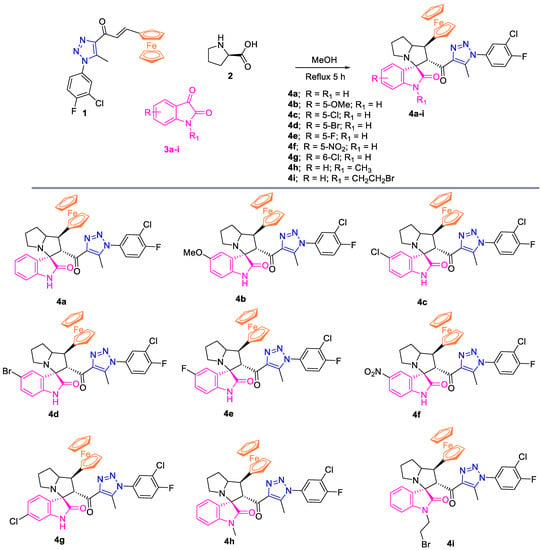
Scheme 1.
Synthetic route for the new spirooxindole analogs 4a-i engrafted with ferrocene and triazole nucleus.
3.2. Crystal-Structure Description of 4b, 4e, 4h and 4i
The X-ray structures of 4b, 4e, 4h and 4i confirmed with no doubt the success of the synthesis of the target compounds, as shown in Figure 2. All crystal data and refinement parameters are listed in Table 1.
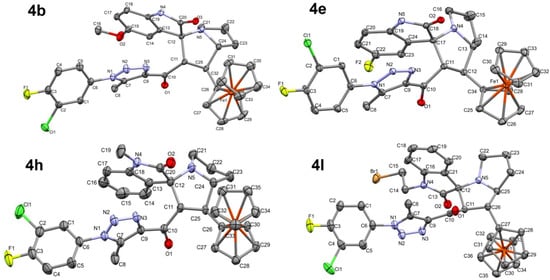
Figure 2.
X-Ray structure of 4b, 4e, 4h and 4i. All hydrogen atoms were removed for better clarity. A summary of the most important distances is given in Table S1 (Supplementary Materials). For color codes: grey (carbon), red (oxygen), blue (nitrogen), green (chlorine), yellow (fluorine), brown (iron) and orange (bromine).

Table 1.
Crystal data of 4b, 4e, 4h and 4i.
Compound 4b crystallizes in the triclinic crystal system and the P-1 space group with Z = 2. The crystal parameters are presented in Table 1. Selected bond distances are given in Table S1 (Supplementary Materials). The asymmetric formula comprised one molecule of the target compound and one dichloromethane as the crystal solvent, which are connected with one another by weak C36-H36A⋯N5 and C36-H36A⋯O3 interactions. The hydrogen-acceptor distances are 3.546(3) and 3.215(3) Å, respectively (Figure 3).
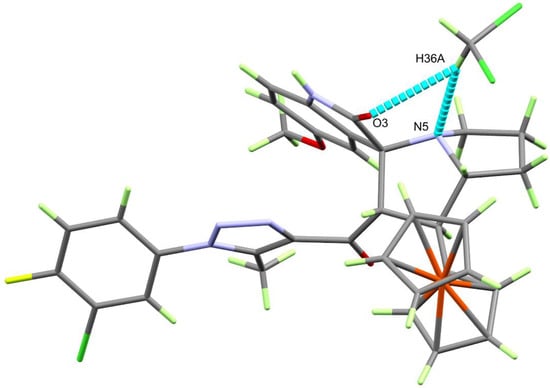
Figure 3.
The C-H⋯N and C-H⋯O interactions between the target compound and the crystal solvent (CH2Cl2). For color codes: grey (carbon), red (oxygen), blue (nitrogen), green (chlorine), yellow (fluorine), brown (iron), light green (hydrogen).
Every two molecules of the target compound are connected by the classical N4-H4⋯O3 hydrogen bonding interaction. The hydrogen bond parameters are depicted in Table 2, while the hydrogen bond dimer is shown in Figure 4.

Table 2.
Hydrogen bonds in 4b, 4h and 4i.
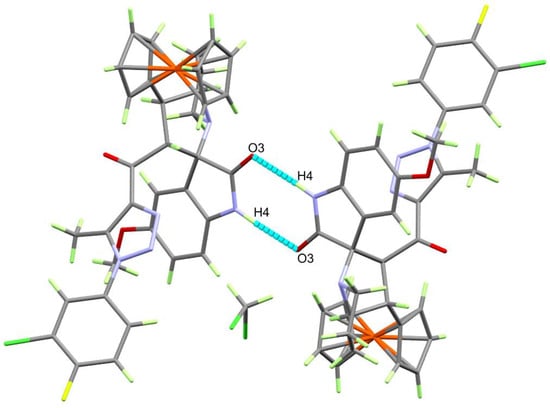
Figure 4.
Centrosymmetric hydrogen-bonded dimer in 4b. For color codes: grey (carbon), red (oxygen), blue (nitrogen), green (chlorine), yellow (fluorine), brown (iron) and light green (hydrogen).
Additionally, the molecules of 4b are further connected by weak nonclassical C-H⋯N and C-H⋯O interactions shown in the upper part of Figure S1 (Supplementary Materials) and listed in Table 2. The molecular packing schemes are shown in the lower part of Figure S1 (Supplementary Materials).
The compounds 4h and 4i crystallize in the monoclinic crystal system with Z = 4. The unit cell parameters are depicted in Table 1. For these compounds, the packing is dominated by many weak interactions (Table 2). The presentation of these weak contacts found in 4h and 4i is shown in Figure 5. Since the structure of 4e comprised an indefinite amount of crystallized solvent, which was squeezed from the structure, the different intermolecular contacts the contributed to the molecular packing of this structure will not be described.
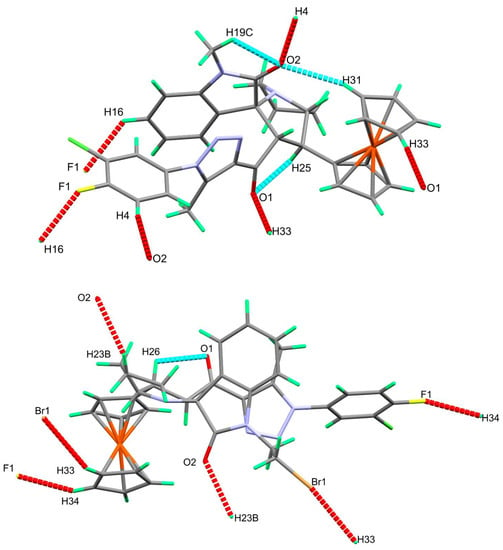
Figure 5.
The most important interactions in the molecular packing of 4h (upper) and 4i (lower). For color codes: grey (carbon), red (oxygen), blue (nitrogen), yellow (fluorine), brown (iron), orange (bromine) and light green (hydrogen).
3.3. Hirshfeld Surface Analysis
In order to describe the different intermolecular contacts in the crystal structure of 4b in detail, Hirshfeld calculations were performed. Different Hirshfeld surfaces are presented in Figure 6. The presence of a large number of red spots indicates regions in which there are important short-distance contacts. There are many O⋯H, N⋯H, C⋯H and H⋯H contacts occurring at shorter distances than the interacting atoms. The percentages of these contacts are 9.2%, 8.2%, 12.6% and 41.9%, respectively. Other contacts, such as Cl⋯H and F⋯H, contributed 15.1% and 5.7%, but they occurred at long interaction distances and hence are considered weak. Many contacts that also occurred at long interaction distances and contributed less to the molecular packing of 4b are depicted in Figure 7.
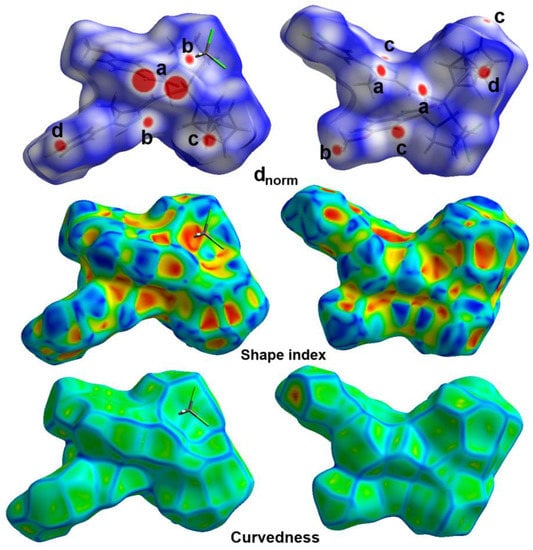
Figure 6.
Hirshfeld surfaces of 4b. The O⋯⋯H (a), N⋯⋯H (b), H⋯⋯C (c) and H⋯⋯H (d) appeared as red spots in dnorm.
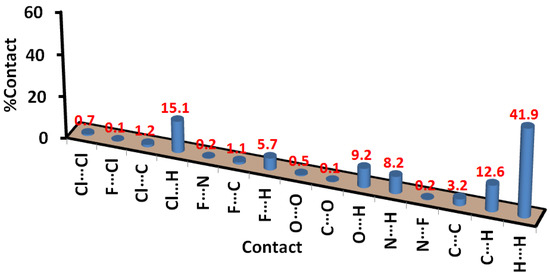
Figure 7.
Intermolecular contacts and their percentages in 4b.
Analysis of the fingerprint plots of the O⋯⋯H, N⋯⋯H, C⋯⋯H and H⋯⋯H contacts leave no doubt about the high percentages of the majority of these contacts and also that these interactions occur at short distances, as indicated from the sharp spikes corresponding to the O⋯⋯H, N⋯⋯H and C⋯⋯H contacts (Figure 8). The O1⋯⋯H8A (2.385 Å), O3⋯⋯H4 (1.814 Å), O3⋯⋯H36A (2.563 Å), N3⋯⋯H16B (2.447 Å), C7⋯⋯H33 (2.690 Å) and C32⋯⋯H14 (2.525 Å) are the shortest intermolecular interactions that occurred in 4b. In contrast, H4A⋯⋯H29 (2.295 Å) is the shortest H⋯⋯H interaction, but it is slightly longer than the sum of the vdWs radii of two hydrogen atoms. Hence, the hydrogenic interactions are considered weak, long-distance contacts.
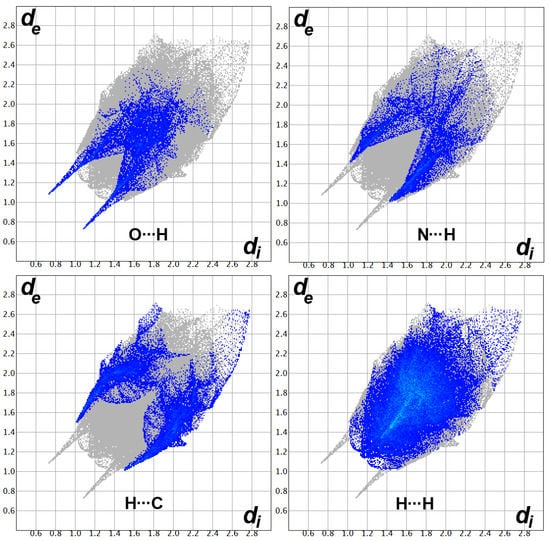
Figure 8.
Decomposed fingerprint plots for short contacts in 4b.
Interestingly, the careful inspection of the dnorm map revealed the presence of two red spots corresponding to the short C4⋯⋯C2 (3.356 Å) contact. In the same region, there are red/blue triangle combinations in the shape index map. All these features revealed the importance of the π-π stacking interactions in the molecular packing of 4b (Figure 9).

Figure 9.
The dnorm (left), fingerprint plot (middle) and shape index (right) of π-π stacking interactions in 4b.
The Hirshfeld analysis of 4h sheds light on the significant intermolecular contacts in its crystal structure. Based on the present red spots in the dnorm map, the O⋯⋯H, N⋯⋯H, C⋯⋯H and H⋯⋯H contacts, as well as little contributions from the F⋯⋯H and F⋯⋯F interactions, are important in the molecular packing of 4h (Figure 10). The distance of the F1⋯⋯F1 interhalogen interaction is 2.713 Å and contributes only 0.7% to the molecular packing. In addition, there are some Cl1⋯⋯N5 (3.281 Å) contacts that contribute 0.5% of the whole contacts. The percentages of the other contacts are presented in Figure 11. It is clear that the major contacts are the H⋯⋯H, C⋯⋯H and Cl⋯⋯H interactions.
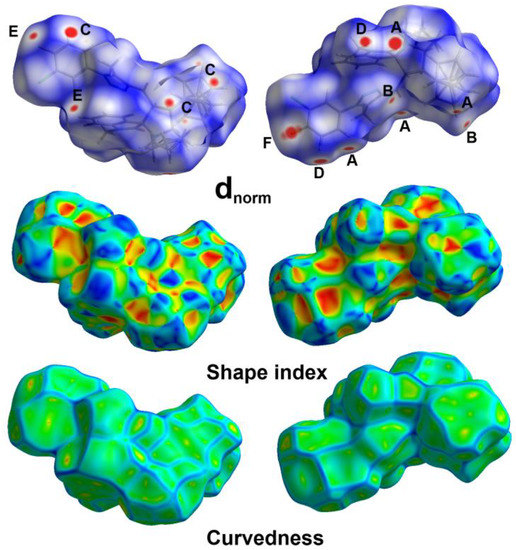
Figure 10.
Hirshfeld surfaces of 4h. O⋯⋯H (A), N⋯⋯H (B), H⋯⋯C (C), H⋯⋯H (D), F⋯⋯H (E) and F⋯⋯F (F) appeared as red spots in dnorm.
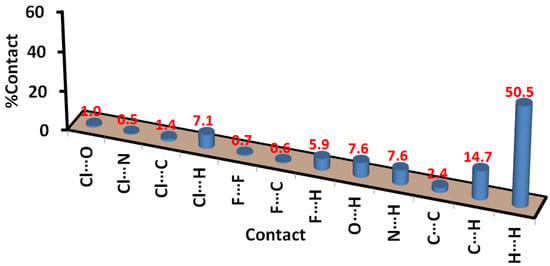
Figure 11.
Intermolecular contacts and their percentages in 4h.
The fingerprint plots of the most important contacts are shown in Figure 12, while a list of the short contacts is summarized in Table 3. As can be seen, there are short H⋯⋯H, O⋯⋯H, N⋯⋯H, C⋯⋯H, F⋯⋯H, F⋯⋯F and Cl⋯⋯N contacts, as indicated by their appearance as sharp spikes in the fingerprint plots. Further, all the contacts presented in Table 3 are shorter than the vdWs radii sum of the interacting atoms.
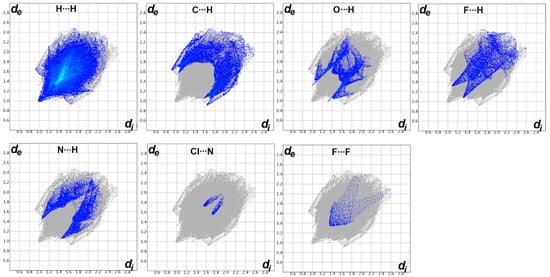
Figure 12.
Decomposed fingerprint plots for short contacts in 4h.

Table 3.
The short contacts in 4h and 4i.
In this case, the shortest π-π interaction occurred between C33 of the cyclopentadienyl moiety and the C17 atom, where the interaction distance is 3.432 Å, which is slightly longer than the vdWs radii sum of two carbon atoms. Hence, the π-π stacking interactions appeared as a white region in the dnorm. Further, the shape index revealed the presence of π-π stacking interactions where the percentage of the C⋯⋯C contacts is 2.4% (Figure 13).

Figure 13.
The dnorm (left), fingerprint plot (middle) and shape index (right) of π-π stacking interactions in 4h.
For 4i, the O⋯⋯H, N⋯⋯H, C⋯⋯H, Br⋯⋯H and F⋯⋯H contacts are the most important in the molecular packing based on Hirshfeld analysis (Figure 14). Their percentages are 6.8%, 5.5%, 12.7%, 9.2% and 6.6%, respectively (Figure 15). The shortest O⋯⋯H, N⋯⋯H, C⋯⋯H, Br⋯⋯H and F⋯⋯H contacts are listed in Table 3. All these interactions have the characteristic of short-distance interactions as these contacts appeared as red spots in the dnorm and sharp spikes in the fingerprint plot (Figure 16). Similar to 4i, the π-π interactions occurred at longer distances than the vdWs radii sum of two carbon atoms. The shortest π-π interactions are C3⋯⋯C29 and C2⋯⋯C30 contacts, which also occurred between the cyclopentadienyl moiety and aromatic carbon atoms of the aryl group from an adjacent molecule (Figure S2, Supplementary Materials).

Figure 14.
Hirshfeld surfaces of 4i. The O⋯⋯H (A), N⋯⋯H (B), C⋯⋯H (C), Br⋯⋯H (D) and F⋯⋯H (E) appeared as red spots in dnorm.
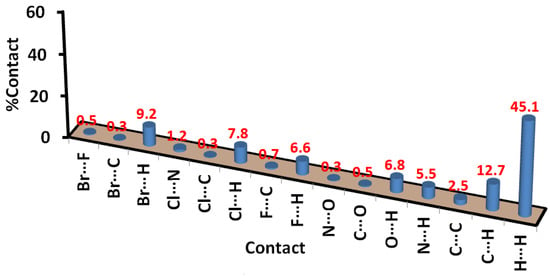
Figure 15.
Intermolecular contacts and their percentages in 4i.
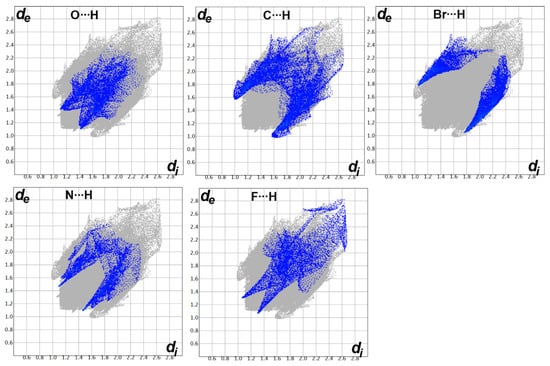
Figure 16.
Decomposed fingerprint plots for short contacts in 4i.
3.4. MEDT Study of the 32CA Reaction of AY 5b with Ferrocene Ethylene Derivative 1
The behaviors of the 32CA reaction of AY 5b with ferrocene ethylene 1 were studied within MEDT [43] (see Scheme 2).

Scheme 2.
Studied 32CA reactions of AY 5b with ferrocene ethylene 1.
3.4.1. Conceptual DFT Analysis at the Ground State of the Reagents
Analysis of the CDFT reactivity indices [50,51] at the ground state of the reagents is a powerful tool for understanding the reactivity of polar processes [61]. The global reactivity indices, namely, the electronic chemical potential μ, chemical hardness η, electrophilicity ω and nucleophilicity N indices of AY 5b and ferrocene ethylene 1 are gathered in Table 4.

Table 4.
B3LYP/6-31G(d) electronic chemical potential μ, chemical hardness η, electrophilicity ω and nucleophilicity N indices, in eV, of AY 5b and ferrocene ethylene 1.
The electronic chemical potential [62] of AY 5b, μ = −2.61 eV, is above that of ferrocene ethylene 1, μ = −3.65 eV, showing that along a polar 32CA reaction, the GEDT [47] will flux from AY 5b to the ferrocene ethylene 1, in a reaction of forward electron density flux (FEDF) [63].
AY 5b has an electrophilicity ω index [64] of 1.07 eV and a nucleophilicity N index [65] of 4.91 eV. Consequently, AY 5b is classified as a moderate electrophile and a strong nucleophile within the electrophilicity and electrophilicity scales [51]. The very strong nucleophilic character of AY 5b, higher than 4.0 eV, classifies it as a supernucleophile [51]. On the other hand, ferrocene ethylene 1 has an electrophilicity ω index of 1.87 eV and a nucleophilicity N index of 3.70 eV; thus, it is classified as a strong electrophile and strong nucleophile. The supernucleophilic character of AY 5b and the strong electrophilic character of ferrocene ethylene 1 point out the high polar character of this 32CA reaction of FEDF [63].
3.4.2. Study of the Reaction Mechanism of the 32CA Reaction of AY 5b with Ferrocene Ethylene 1
Exploration of the ortho/endo reaction path of this 32CA reaction shows that it proceeds via a one-step mechanism (see Scheme 3). Relative electronic energies, in the gas phase and in methanol, of the stationary points involved in this 32CA reaction, are given in Scheme 3. The total electronic energies are given in Table S2 in the Supplementary Materials.
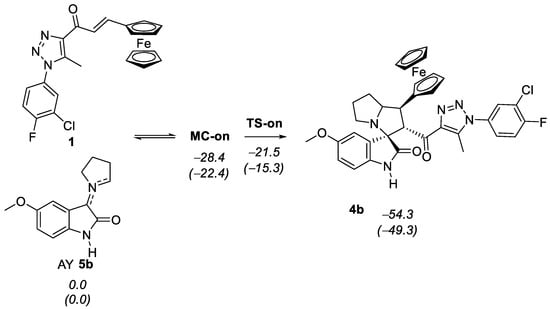
Scheme 3.
32CA reaction of AY 5b with ferrocene ethylene 1. Relative electronic energies, with respect to separated reagents, are indicated in italics in kcal·mol−1. ωB97X-D/6-311G(d,p) relative energies in methanol are given in parenthesis.
An exploration of the potential energy surface allows the characterizing of a molecular complex, MC-on, in the initial stage of the reaction. MC-on, which opens the ortho/endo reaction path, is positioned 28.4 kcal·mol−1 below the separated reagents. TS-on is 21.5 kcal·mol−1 more stable than the separated reagents. The gas phase activation energy of this 32CA reaction with respect to MC-on is positive by 6.8 kcal·mol−1. This reaction is strongly exothermic by −54.3 kcal·mol−1.
The solvent effects of methanol decrease the gas phase relative energies of all species participating in this 32CA reaction by between 5.1 and 6.2 kcal mol−1 due to better solvation of the reagents than the other species (see Table S2 in Supplementary Materials). As a consequence, in methanol, the activation energy increases slightly to 7.1 kcal mol−1.
A representation of the enthalpy and Gibbs free-energy profiles associated with the 32CA reaction of AY 5b with ferrocene ethylene 1 is given in Figure 17. The total and relative enthalpies, entropies and Gibbs free energies are given in Table S3 in the Supplementary Materials. Adding the thermal corrections to the electronic energies in methanol reduces the relative enthalpies by between 1.0 and 3.4 kcal·mol−1. The relative Gibbs free energies are computed to be between 18 and 22 kcal·mol−1 above the enthalpies as a consequence of the unfavorable activation entropies associated with this bimolecular process, which vary between −54 and −64 cal·mol−1·K−1. From MC-on, the activation Gibbs free energy associated with this 32CA reaction via TS-on increases to 9.2 kcal·mol−1; the formation of 4a is exergonic by −26.1 kcal·mol−1. It is interesting to highlight that the formation of MC-on remains exergonic by −5.0 kcal·mol−1; note that in many 32CA reactions, the formation of this MC is exothermic but endergonic as a consequence of the unfavorable entropic factor associated with their formation.
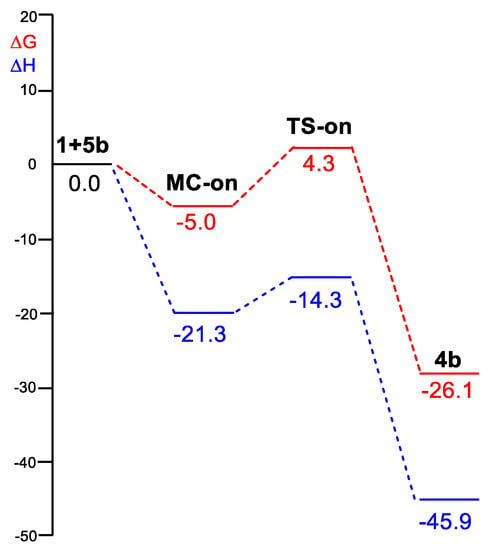
Figure 17.
Profiles of MPWB1K/6-311G(d,p) enthalpy (in blue), ΔH in kcal·mol−1, and Gibbs free energy (in red), ΔG in kcal·mol−1, in methanol 1 M at 65 °C, for the 32CA reaction of AY 5b with ferrocene ethylene 1.
The geometries of MC-on and TS-on are given in Figure 18. At MC-on, the two interacting species, which show a parallel disposition, are separated by a distance of ca 3.1 Å. At TS-on, the distances between the two pairs of interacting carbons, 2.130 and 2.730 Å, show that it is associated with a highly asynchronous C–C single bond formation process resulting from the two-center interaction between the C4 carbon of ferrocene ethylene 1, and the C3 carbon of AY 5b. This behavior points out that this 32CA reaction proceeds via a non-concerted two-stage one-step mechanism [66] in which the formation of the second C1–C5 single bond begins when the first C3–C4 single bond is practically formed. The solvent effects of methanol do not produce any remarkable change in the gas phase geometries (see Figure 18).
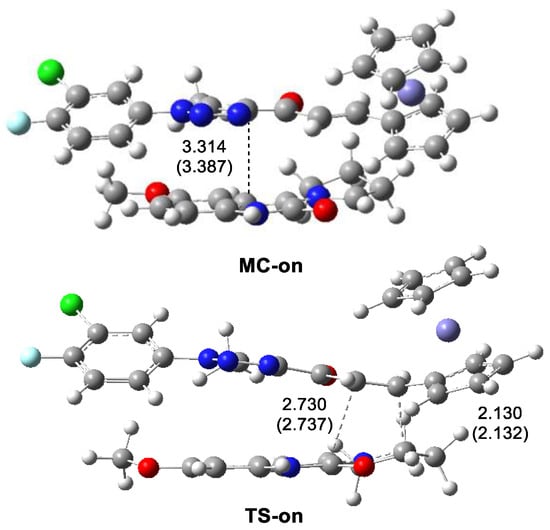
Figure 18.
ωB97X-D/6-311G(d,p) geometries of MC-on and TS-on. The distances are given in Angstrom. Distances in methanol are given in parenthesis.
Finally, the analysis of GEDT [47] at TS-on allows characterizing the polar character of this 32CA reaction. GEDT values lower than 0.05 e correspond to non-polar processes, while values higher than 0.20 e correspond to high polar processes. The high GEDT value computed at TS-on, 0.25 e, is a consequence of the supernucleophilic character of AY 5b and the strong nucleophilic character of ferrocene ethylene 1. The flux of the electron density, which goes from AY 5b to ferrocene ethylene 1, classifies this 32CA reaction as FEDF, as previously characterized by the CDFT indices. This high GEDT, which favors the bonding changes along the reaction [67], explains that TS-on is placed below the separated reagents for enthalpy (see Figure 17).
4. Conclusions
In conclusion, we have successfully synthesized a new set of spiroxindole analogs having a triazole unit with a ferrocene scaffold via the 32CA approach. The 32CA reaction between AY 5b and ferrocene ethylene 1 has been studied within MEDT. This 32CA reaction proceeds via a non-concerted two-stage one-step mechanism involving a highly asynchronous TS-on, resulting from the nucleophilic attack of AY 5b on the β-conjugated position of ferrocene ethylene 1. The supernucleophilic character of AY 5b, together with the strong electrophilic character of ferrocene ethylene 1 explain that TS-on will be located below reagents. The high GEDT found at TS-on accounts for the high polar character of this 32CA reaction of FEDT. Single crystals of the synthesized compounds 4b, 4e, 4h and 4i were isolated and examined using X-ray diffraction. The reported structures were found to agree with our synthetic strategy very well. Further, the supramolecular structures of 4b, 4h and 4i were described on the basis of Hirshfeld analysis. For 4b, the O⋯H, N⋯H, C⋯H and H⋯H contacts are the most important. On the other hand, for 4h, the H⋯H, O⋯H, N⋯H, C⋯H, F⋯H, F⋯F and Cl⋯N contacts are the most important, while for 4i, the O⋯H, N⋯H, C⋯H, Br⋯H and F⋯H contacts are the most important. All three compounds showed different extents of π-π stacking interactions.
Supplementary Materials
The following supporting information can be downloaded at: https://www.mdpi.com/article/10.3390/sym14102071/s1. General remarks and X-ray structure determination technical protocol; Tables S1–S3: computational investigations; Figure S1. The C-H⋯N and C-H⋯O contacts (upper) and the corresponding packing scheme (lower) in 4b; Figure S2. The dnorm (left), fingerprint plot (middle) and shape index (right) of π-π stacking interactions in 4i. Figures S3–S16: Selected NMR (1H and 13C) spectrum of the synthesized compounds.
Author Contributions
Conceptualization, A.B.; methodology, H.H.A.-R., A.M.A.-M. and M.A.; software, M.H., S.M.S., L.R.D. and S.R.; validation, S.M.S., A.E.-F. and L.R.D.; formal analysis, H.H.A.-R., M.A. and S.R.; investigation, H.H.A.-R., A.M.A.-M. and M.A.; resources, A.B.; data curation, M.H., S.M.S., L.R.D. and S.R.; writing—original draft preparation, All authors; writing—review and editing, A.E.-F., S.M.S., L.R.D. and A.B.; supervision, A.B.; funding acquisition, A.B. All authors have read and agreed to the published version of the manuscript.
Funding
The authors would like to extend their sincere appreciation to the Researchers Supporting Project (RSP-2021/64), King Saud University, Riyadh, Saudi Arabia, and the Ministerio de Ciencias, Innovación y Universidades of the Spanish Government, project PID2019-110776GB-I00 (AEI/FEDER, UE).
Institutional Review Board Statement
Not applicable.
Informed Consent Statement
Not applicable.
Data Availability Statement
The data presented in this study are not available on request from the corresponding author.
Acknowledgments
The authors would like to extend their sincere appreciation to the Researchers Supporting Project (RSP-2021/64), King Saud University, Riyadh, Saudi Arabia, and the Ministerio de Ciencias, Innovación y Universidades of the Spanish Government, project PID2019-110776GB-I00 (AEI/FEDER, UE).
Conflicts of Interest
The authors declare no conflict of interest.
References
- Cerulli, V.; Banfi, L.; Basso, A.; Rocca, V.; Riva, R. Diversity oriented and chemoenzymatic synthesis of densely functionalized pyrrolidines through a highly diastereoselective Ugimulticomponent reaction. Org. Biomol. Chem. 2012, 10, 1255–1274. [Google Scholar] [CrossRef] [PubMed]
- Ganem, B. Strategies for innovation in multicomponent reaction design. Acc. Chem. Res. 2009, 42, 463–472. [Google Scholar] [CrossRef] [PubMed]
- Domling, A. Recent developments in isocyanide based multicomponent reactions in applied chemistry. Chem. Rev. 2006, 106, 17–89. [Google Scholar] [CrossRef]
- Trost, B.M.; Brennan, M.K. Asymmetric Syntheses of Oxindole and Indole Spirocyclic Alkaloid Natural Products. Synthesis 2009, 2009, 3003–3025. [Google Scholar] [CrossRef]
- Jossang, A.; Jossang, P.; Hadi, H.A.; Sevenet, T.; Bodo, B. Horsfiline, an oxindole alkaloid from Horsfieldia superba. J. Org. Chem. 1991, 56, 6527–6530. [Google Scholar] [CrossRef]
- Cui, C.B.; Kakeya, H.; Osada, H. Novel mammalian cell cycle inhibitors, spirotryprostatins A and B, produced by Aspergillus fumigatus, which inhibit mammalian cell cycle at G2/M phase. Tetrahedron 1996, 52, 12651–12666. [Google Scholar] [CrossRef]
- Prado, E.G.; Gimenez, M.D.G.; Vazquez, R.D.L.P.; Sanchez, J.L.E.; Rodriguez, M.T.S. Antiproliferative effects of mitraphylline, a pentacyclic oxindole alkaloid of Uncaria tomentosa on human glioma and neuroblastoma cell lines. Phytomedicine 2007, 14, 280–287. [Google Scholar] [CrossRef] [PubMed]
- Al-Majid, A.M.; Ali, M.; Islam, M.S.; Alshahrani, S.; Alamary, A.S.; Yousuf, S.; Choudhary, M.I.; Barakat, A. Stereoselective Synthesis of the Di-Spirooxindole Analogs Based Oxindole and Cyclohexanone Moieties as Potential Anticancer Agents. Molecules 2021, 26, 6305. [Google Scholar] [CrossRef] [PubMed]
- Barakat, A.; Islam, M.S.; Ali, M.; Al-Majid, A.M.; Alshahrani, S.; Alamary, A.S.; Yousuf, S.; Choudhary, M.I. Regio- and Stereoselective Synthesis of a New Series of Spirooxindole Pyrrolidine Grafted Thiochromene Scaffolds as Potential Anticancer Agents. Symmetry 2021, 13, 1426. [Google Scholar] [CrossRef]
- Kornet, M.J.; Thio, A.P. Oxindole-3-spiropyrrolidines and piperidines. Synthesis and local anesthetic activity. J. Med. Chem. 1976, 19, 892–898. [Google Scholar] [CrossRef]
- Rajanarendar, E.; Ramakrishna, S.; Reddy, K.G.; Nagaraju, D.; Reddy, Y.N. A facile synthesis, anti-inflammatory and analgesic activity of isoxazolyl-2,3- dihydrospiro[benzo[f]isoindole-1,30-indoline]-20,4,9-triones. Bioorg. Med. Chem. Lett. 2013, 23, 3954–3958. [Google Scholar] [CrossRef]
- Rajesh, M.; Perumal, S.; Menéndez, J.C.; Yogeeswari, P.; Sriram, D. Antimycobacterial activity of spirooxindolo-pyrrolidine, pyrrolizine and pyrrolothiazole hybrids obtained by a three-component regio- and stereoselective 1,3-dipolar cycloaddition. Med. Chem. Commun. 2011, 2, 626–630. [Google Scholar] [CrossRef]
- Bhaskar, G.; Arun, Y.; Balachandran, C.; Saikumar, C.; Perumal, P.T. Synthesis of novel spirooxindole derivatives by one pot multicomponent reaction and their antimicrobial activity. Eur. J. Med. Chem. 2012, 51, 79–91. [Google Scholar] [CrossRef] [PubMed]
- Altowyan, M.S.; Barakat, A.; Al-Majid, A.M.; Al-Ghulikah, H.A. Spiroindolone Analogues as Potential Hypoglycemic with Dual Inhibitory Activity on α-Amylase and α-Glucosidase. Molecules 2019, 24, 2342. [Google Scholar] [CrossRef] [PubMed]
- Zhou, W.H.; Xu, X.G.; Li, J.; Min, X.; Yao, J.Z.; Dong, G.Q.; Zhuang, C.L.; Miao, Z.Y.; Zhang, W.N. Design, synthesis and structure–activity relationship of 4, 5-dihydropyrrolo [3, 4-c] pyrazol-6 (1H)-ones as potent p53-MDM2 inhibitors. Chin. Chem. Lett. 2017, 28, 422–425. [Google Scholar] [CrossRef]
- Barakat, A.; Alshahrani, S.; Al-Majid, A.M.; Alamary, A.S.; Haukka, M.; Abu-Serie, M.M.; Dömling, A.; Mazyed, E.A.; Badria, F.A.; El-Senduny, F.F. Novel spirooxindole based benzimidazole scaffold: In vitro, nanoformulation and in vivo studies on anticancer and antimetastatic activity of breast adenocarcinoma. Bioorg. Chem. 2022, 129, 106124. [Google Scholar] [CrossRef]
- Arumugam, N.; Almansour, A.I.; Kumar, R.S.; Dege, N. A facile ionic liquid-accelerated, four-component cascade reaction protocol for the regioselective synthesis of biologically interesting ferrocene engrafted spiropyrrolidine hybrid heterocycles. J. King Saud Univ. Sci. 2020, 32, 2500–2504. [Google Scholar] [CrossRef]
- Zhou, L.-M.; Qu, R.-Y.; Yang, G.-F. An overview of spirooxindole as a promising scaffold for novel drug discovery. Expert Opin. Drug Discov. 2020, 15, 603–625. [Google Scholar] [CrossRef]
- Barakat, A.; Alshahrani, S.; Al-Majid, A.M.; Ali, M.; Altowyan, M.S.; Islam, M.S.; Alamary, A.S.; Ashraf, S.; Ul-Haq, Z. Synthesis of a new class of spirooxindole–benzo[b]thiophene-based molecules as acetylcholinesterase inhibitors. Molecules 2020, 25, 4671. [Google Scholar] [CrossRef]
- Lotfy, G.; Aziz, Y.M.A.; Said, M.M.; El Ashry, E.S.H.; El Tamany, E.S.H.; Abu-Serie, M.M.; Teleb, M.; Dömling, A.; Barakat, A. Molecular hybridization design and synthesis of novel spirooxindole-based MDM2 inhibitors endowed with BCL2 signaling attenuation; a step towards the next generation p53 activators. Bioorg. Chem. 2021, 117, 105427. [Google Scholar] [CrossRef]
- Astruc, D. Why is Ferrocene so Exceptional? Eur. J. Inorg. Chem. 2017, 1, 6–29. [Google Scholar] [CrossRef]
- Gasser, G.; Metzler-Nolte, N. The potential of organometallic complexes in medicinal chemistry. Curr. Opin. Chem. Biol. 2012, 16, 84–91. [Google Scholar] [CrossRef]
- Santos, M.M.; Bastos, P.; Catela, I.; Zalewska, K.; Branco, L.C. Recent advances of metallocenes for medicinal chemistry. Mini-Rev. Med. Chem. 2017, 17, 771–784. [Google Scholar] [CrossRef]
- Top, S.; Vessières, A.; Leclercq, G.; Quivy, J.; Tang, J.; Vaissermann, J.; Huché, M.; Jaouen, G. Synthesis, biochemical properties and molecular modelling studies of organometallic specific estrogen receptor modulators (SERMs), the ferrocifens and hydroxyferrocifens: Evidence for an antiproliferative effect of hydroxyferrocifens on both hormone-dependent and hormone-independent breast cancer cell lines. Chem. A Eur. J. 2003, 9, 5223–5236. [Google Scholar]
- Dubar, F.; Khalife, J.; Brocard, J.; Dive, D.; Biot, C. Ferroquine, an ingenious antimalarial drug-thoughts on the mechanism of action. Molecules 2008, 13, 2900–2907. [Google Scholar] [CrossRef]
- Ferreira, V.F.; da Rocha, D.R.; da Silva, F.C.; Ferreira, P.G.; Boechat, N.A.; Magalhães, J.L. Novel 1 H-1, 2, 3-, 2 H-1, 2, 3-, 1 H-1, 2, 4-and 4 H-1, 2, 4-triazole derivatives: A patent review (2008–2011). Expert Opin. Ther. Pat. 2013, 23, 319–331. [Google Scholar] [CrossRef]
- Salmon, A.J.; Williams, M.L.; Wu, Q.K.; Morizzi, J.; Gregg, D.; Charman, S.A.; Vullo, D.; Supuran, C.T.; Poulsen, S.A. Metallocene-based inhibitors of cancerassociated carbonic anhydrase enzymes IX and XII. J. Med. Chem. 2012, 55, 5506–5517. [Google Scholar] [CrossRef] [PubMed]
- Kumar, K.; Carrere-Kremer, S.; Kremer, L.; Guerardel, Y.; Biot, C.; Kumar, V. 1 H-1, 2, 3-triazole-tethered isatineferrocene and isatineferrocenylchalcone conjugates: Synthesis and in vitro antitubercular evaluation. Organometallics 2013, 32, 5713–5719. [Google Scholar] [CrossRef]
- Kumar, K.; Carrère-Kremer, S.; Kremer, L.; Guérardel, Y.; Biot, C.; Kumar, V. Azide–alkyne cycloaddition en route towards 1 H-1, 2, 3-triazole-tethered β-lactam–ferrocene and β-lactam–ferrocenylchalcone conjugates: Synthesis and in vitro anti-tubercular evaluation. Dalton Trans. 2013, 42, 1492–1500. [Google Scholar] [CrossRef]
- Kumar, K.; Pradines, B.; Madamet, M.; Amalvict, R.; Benoit, N.; Kumar, V. 1H-1, 2, 3-triazole tethered isatin-ferrocene conjugates: Synthesis and in vitro antimalarial evaluation. Eur. J. Med. Chem. 2014, 87, 801–804. [Google Scholar] [CrossRef] [PubMed]
- Van Staveren, D.R.; Metzler-Nolte, N. Bioorganometallic chemistry of ferrocene. Chem. Rev. 2004, 104, 5931–5986. [Google Scholar] [CrossRef] [PubMed]
- Xu, J.; Yang, Y.; Baigude, H.; Zhao, H. New ferrocene–triazole derivatives for multisignaling detection of Cu2+ in aqueous medium and their antibacterial activity. Spectrochim. Acta Part A Mol. Biomol. Spectrosc. 2020, 229, 117880. [Google Scholar] [CrossRef] [PubMed]
- Arivazhagan, C.; Borthakur, R.; Ghosh, S. Ferrocene and triazole-appended rhodamine based multisignaling sensors for Hg2+ and their application in live cell imaging. Organometallics 2015, 34, 1147–1155. [Google Scholar] [CrossRef]
- Fouda, M.F.; Abd-Elzaher, M.M.; Abdelsamaia, R.A.; Labib, A.A. On the medicinal chemistry of ferrocene. Appl. Organomet. Chem. 2007, 21, 613–625. [Google Scholar] [CrossRef]
- Larik, F.A.; Saeed, A.; Fattah, T.A.; Muqadar, U.; Channar, P.A. Recent advances in the synthesis, biological activities and various applications of ferrocene derivatives. Appl. Organomet. Chem. 2017, 31, e3664. [Google Scholar] [CrossRef]
- Domingo, L.R.; Ríos-Gutiérrez, M.; Barakat, A. A molecular electron density theory study of the [3+2] cycloaddition reaction of an azomethine ylide with an electrophilic ethylene linked to triazole and ferrocene units. Molecules 2022, 27, 6532. [Google Scholar] [CrossRef] [PubMed]
- Haque, A.; Hsieh, M.F.; Hassan, S.I.; Faizi, M.S.H.; Saha, A.; Dege, N.; Rather, J.A.; Khan, M.S. Synthesis, characterization, and pharmacological studies of ferrocene-1H-1, 2, 3-triazole hybrids. J. Mol. Struct. 2017, 1146, 536–545. [Google Scholar] [CrossRef]
- Ríos-Gutiérrez, M.; Barakat, A.; Domingo, L.R. A Molecular Electron Density Theory Study of the [3 + 2] Cycloaddition Reaction of Pseudo(mono)radical Azomethine Ylides with Phenyl Vinyl Sulphone. Organics 2022, 3, 122–136. [Google Scholar] [CrossRef]
- Barakat, A.; Haukka, M.; Soliman, S.M.; Ali, M.; Al-Majid, A.M.; El-Faham, A.; Domingo, L.R. Straightforward regio- and diastereoselective synthesis, molecular structure, intermolecular interactions and mechanistic study of spirooxindole-engrafted rhodanine analogs. Molecules 2021, 26, 7276. [Google Scholar] [CrossRef]
- Altowyan, M.S.; Soliman, S.M.; Haukka, M.; Al-Shaalan, N.H.; Alkharboush, A.A.; Barakat, A. Synthesis and Structure Elucidation of Novel Spirooxindole Linked to Ferrocene and Triazole Systems via [3 + 2] Cycloaddition Reaction. Molecules 2022, 27, 4095. [Google Scholar] [CrossRef] [PubMed]
- Chai, J.-D.; Head-Gordon, M. Long-range corrected hybrid density functionals with damped atom–atom dispersion corrections. Phys. Chem. Chem. Phys. 2008, 10, 6615–6620. [Google Scholar] [CrossRef] [PubMed]
- Hehre, M.J.; Radom, L.; Schleyer, P.V.R.; Pople, J. Ab Initio Molecular Orbital Theory; Wiley: New York, NY, USA, 1986. [Google Scholar]
- Domingo, L.R. Molecular electron density theory: A modern view of reactivity in organic chemistry. Molecules 2016, 21, 1319. [Google Scholar] [CrossRef] [PubMed]
- Tomasi, J.; Persico, M. Molecular interactions in solution: And overview of methods based on continuous distributions of the solvent. Chem. Rev. 1994, 94, 2027–2094. [Google Scholar] [CrossRef]
- Simkin, B.Y.; Sheikhet, I.I. Quantum Chemical and Statistical Theory of Solutions—Computational Approach; Ellis Horwood: London, UK, 1995. [Google Scholar]
- Marenich, A.V.; Cramer, C.J.; Truhlar, D.G. Universal Solvation Model Based on Solute Electron Density and on a Continuum Model of the Solvent Defined by the Bulk Dielectric Constant and Atomic Surface Tensions. J. Phys. Chem. B 2009, 113, 6378–6396. [Google Scholar] [CrossRef] [PubMed]
- Domingo, L.R. A new C–C bond formation model based on the quantum chemical topology of electron density. RSC Adv. 2014, 4, 32415–32428. [Google Scholar] [CrossRef]
- Reed, A.E.; Weinstock, R.B.; Weinhold, F. Natural population analysis. J. Chem. Phys. 1985, 83, 735–746. [Google Scholar] [CrossRef]
- Reed, A.E.; Curtiss, L.A.; Weinhold, F. Intermolecular interactions from a natural bond orbital, donor-acceptor viewpoint. Chem. Rev. 1988, 88, 899–926. [Google Scholar] [CrossRef]
- Parr, R.G.; Yang, W. Density Functional Theory of Atoms and Molecules; Oxford University Press: Oxford, UK, 1989. [Google Scholar]
- Domingo, L.R.; Ríos-Gutiérrez, M.; Pérez, P. Applications of the conceptual density functional indices to organic chemistry reactivity. Molecules 2016, 21, 748. [Google Scholar] [CrossRef]
- Frisch, M.J.; Trucks, G.W.; Schlegel, H.B.; Scuseria, G.E.; Robb, M.A.; Cheeseman, J.R.; Scalmani, G.; Barone, V.; Petersson, G.A.; Nakatsuji, H.; et al. (Eds.) Gaussian 16, Revision A.03; Gaussian, Inc.: Wallingford, CT, USA, 2016. [Google Scholar]
- Otwinowski, Z.; Minor, W. Processing of X-ray Diffraction Data Collected in Oscillation Mode. In Methods in Enzymology, Macromolecular Crystallography, Part A; Carter, C.W., Sweet, J., Eds.; Academic Press: New York, NY, USA, 1997; Volume 276, pp. 307–326. [Google Scholar]
- Rikagu Oxford Diffraction. CrysAlisPro; Rikagu Oxford Diffraction Inc.: Oxfordshire, UK, 2022. [Google Scholar]
- Sheldrick, G.M. SADABS—Bruker Nonius Scaling and Absorption Correction; Bruker AXS, Inc.: Madison, WI, USA, 2012. [Google Scholar]
- Sheldrick, G.M. SHELXT-Integrated Space-Group and Crystal-Structure Determination. Acta Crystallogr. Sect. A Found. Adv. 2015, 71, 3–8. [Google Scholar] [CrossRef] [PubMed]
- Sheldrick, G.M. Crystal Structure Refinement with SHELXL. Acta Crystallogr. Sect. C Struct. Chem. 2015, 71, 3–8. [Google Scholar] [CrossRef]
- Hübschle, C.B.; Sheldrick, G.M.; Dittrich, B. ShelXle: A Qt graphical user interface for SHELXL. J. Appl. Crystallogr. 2011, 44, 1281–1284. [Google Scholar] [CrossRef] [PubMed]
- Spek, A.L. PLATON SQUEEZE: A tool for the calculation of the disordered solvent contribution to the calculated structure factors. Acta Crystallogr. Sect. C Struct. Chem. 2015, C71, 148–155. [Google Scholar]
- Turner, M.J.; McKinnon, J.J.; Wolff, S.K.; Grimwood, D.J.; Spackman, P.R.; Jayatilaka, D.; Spackman, M.A. Crystal Explorer17; University of Western Australia: Crawley, WA, Australia, 2017; Available online: http://hirshfeldsurface.net (accessed on 20 July 2020).
- Domingo, L.R.; Ríos-Gutiérrez, M. Application of Reactivity Indices in the Study of Polar Diels–Alder Reactions, in Conceptual Density Functional Theory: Towards a New Chemical Reactivity Theory; Liu, S., Ed.; Wiley-VCH GmbH: Weinheim, Germany, 2022; Volume 2, pp. 481–502. [Google Scholar]
- Parr, R.G.; Pearson, R.G. Absolute hardness: Companion parameter to absolute electronegativity. J. Am. Chem. Soc. 1983, 105, 7512–7516. [Google Scholar] [CrossRef]
- Domingo, L.R.; Ríos-Gutiérrez, M.; Pérez, P. A Molecular Electron Density Theory Study of the Reactivity of Tetrazines in Aza-Diels-Alder Reactions. RSC Adv. 2020, 10, 15394–15405. [Google Scholar] [CrossRef]
- Parr, R.G.; Szentpaly, L.V.; Liu, S. Electrophilicity index. J. Am. Chem. Soc. 1999, 121, 1922–1924. [Google Scholar] [CrossRef]
- Domingo, L.R.; Chamorro, E.; Pérez, P. Understanding the reactivity of captodative ethylenes in polar cycloaddition reactions. A theoretical study. J. Org. Chem. 2008, 73, 4615–4624. [Google Scholar] [CrossRef]
- Domingo, L.R.; Sáez, J.A.; Zaragozá, R.J.; Arnó, M. Understanding the Participation; f Quadricyclane as Nucleophile in Polar [2 sigma+2 sigma+2 pi] Cycloadditions toward Electrophilic pi Molecules. J. Org. Chem. 2008, 73, 8791–8799. [Google Scholar] [CrossRef]
- Domingo, L.R.; Ríos-Gutiérrez, M.; Pérez, P. How does the global electron density transfer diminish activation energies in polar cycloaddition reactions? A Molecular Electron Density Theory study. Tetrahedron 2017, 73, 1718–1724. [Google Scholar] [CrossRef]
Publisher’s Note: MDPI stays neutral with regard to jurisdictional claims in published maps and institutional affiliations. |
© 2022 by the authors. Licensee MDPI, Basel, Switzerland. This article is an open access article distributed under the terms and conditions of the Creative Commons Attribution (CC BY) license (https://creativecommons.org/licenses/by/4.0/).